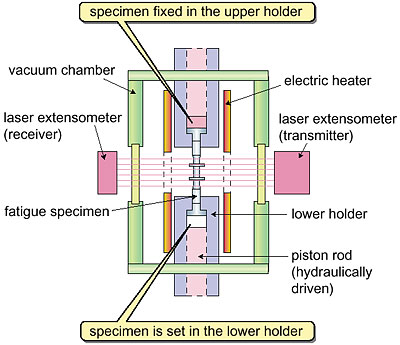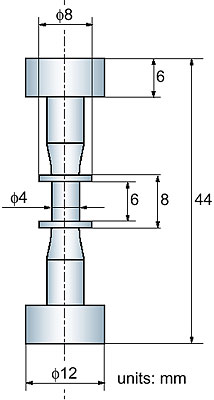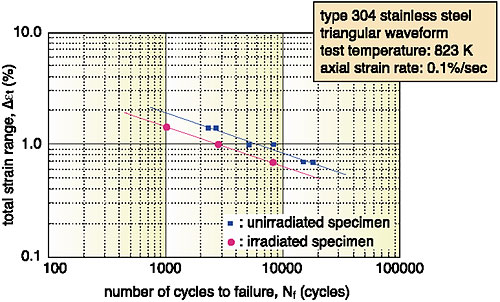Structural materials of a nuclear reactor are subjected to cyclic stress due to vibration and thermal stresses as well as to neutron irradiation during reactor operation. Therefore, to maintain the integrity of nuclear reactors, it is essential to obtain a variety of low-cycle fatigue data of materials irradiated in a research reactor, such as the Japan Materials Testing Reactor.
A remotely controlled, high-temperature fatigue test machine with a laser extensometer was developed to measure strain in specimens at the JMTR hot laboratory. The laser extensometer can measure the strain without a contact to the specimen. Low cycle fatigue and creep fatigue tests of irradiated specimens were performed using this machine. During fatigue tests, the distance between the two disks on the specimen is measured by the laser extensometer with a resolution of 0.1 micrometer and an accuracy of ± 0.5%. The maximum scanning frequency of the laser is 480 Hz. Special integrated-circuits with gamma-radiation resistance are installed in both the transmitter and receiver of the laser extensometer. Further, to improve the strain control, the displacement of the cross head is controlled using a mean value of thirty data from the laser extensometer. With these improvements, a strain-controlled fatigue test using the laser extensometer can be conducted with a complete triangular waveform.
Low-cycle fatigue tests of type 304 stainless steel irradiated in JMTR at 823 K by fast neutron fluences of 1.4 to 3.4 x 1025 n/m2 (E>1 MeV) were conducted at 823 K in a vacuum of ~10-4 Pa under axial strain-controlled conditions. The total strain ranges in the fatigue tests were controlled at 0.7, 1.0, and 1.4% with an axial strain rate of 0.1%/s. Quantitative estimates indicated that neutron irradiation caused a significant reduction in the low-cycle fatigue life of type 304 stainless steel. |


